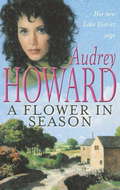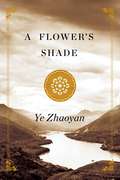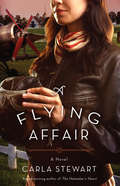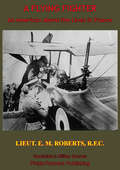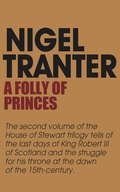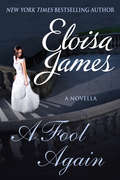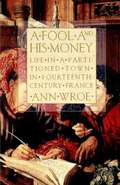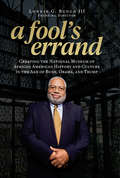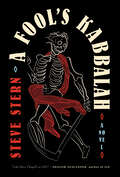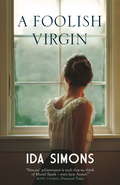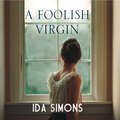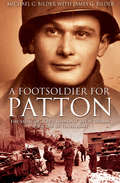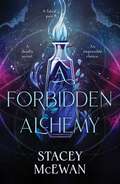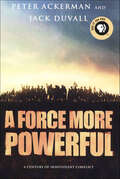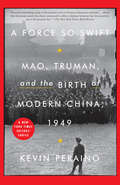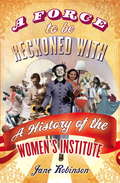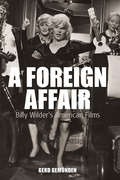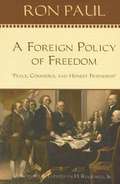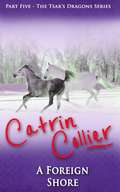- Table View
- List View
A Flower in Season
by Audrey HowardBriony Marsden has led a hard life, forced to do the work of a grown man while enduring her drunkard father’s taunts and blows. But when he goes too far one day, her fate becomes even worse as she makes her way alone in a heartless world. Not quite alone. She has a friend - Lizzie Jenkins - who will do anything to help Briony re-open Moorend Mill. And Chad Cameron, the richest man in the district, has always admired Briony’s spirit and determination. When her fortunes are at their lowest, he falls in love with the elfin waif and decides to make her his wife. But the only way he can win her is by trickery - by betraying her naive trust in the man who came to her rescue when all seemed lost. Can their marriage survive when she discovers his deception?
A Flower's Shade
by Ye ZhaoyanA decadent family drama of incest, addiction, and crime, this seductive novel set in small towns south of the Yangtze River in the 1920s was the basis for the film Temptress Moon.
A Flying Affair
by Carla StewartEver since Mittie Humphreys agreed to join dashing barnstorming pilot Ames for a joyride in his airplane, her lifelong love of horses has been surpassed by one thing--a longing for the skies. It seems she's not the only one--with Charles Lindbergh making his victory tour in the Spirit of St. Louis, aviation fever is spreading across the country. Mittie knows flying is the perfect focus for the soaring ambition and taste for adventure within her, and whenever she can slip away from her duties on her family's prosperous Kentucky horse farm, she heads to the airfield. Considering their shared passion, it's no surprise that Ames begins to vie for Mittie's time. But when handsome British aviator Bobby York offers her flying lessons, he is equally surprised-and beguiled-by Mittie's grit and talent. Driven to succeed, Mittie will do whatever it takes to compete in the Women's National Air Derby alongside Amelia Earhart. But when Calista "Peach" Gilson, a charming Southern belle, becomes her rival both professionally and in love, Mittie must learn how to navigate her heart's romantic longings as well as the skies.
A Flying Fighter: An American Above The Lines In France
by E. M. Roberts"An American eagle with British wingsReaders interested in the personal experiences of the resolute and brave young men who ventured into the air to fight the first aerial combats will discover much to reward them in this book. The author joined the R. F. C in 1914 to fight Germany following its invasion of Belgium and advance into France at the beginning of the First World War. However, he was, in fact an American much taken with the idea of adventure as well as the righting of wrongs. Roberts' first experience of air fighting for the British flying corps was as an observer manning a machine gun and his descriptions of battling enemy aircraft and his accounts of his various 'kills' make gripping reading. Eventually he graduated to the pilot's cockpit where he became an accomplished exponent of the dogfight; this did not come without some cost, Roberts lost many comrades and was seriously wounded himself. This account is highly recommended since it brings to life through many anecdotes the first hand experiences of one who was there. This book is one of a very small number by early military aviators and will be a valuable addition to the library of anyone with an interest in the subject."-Leonaur Print Edition
A Folly of Princes: House of Stewart Trilogy 2
by Nigel TranterScotland at the dawn of the 15th century was a wretched spectacle. Whilethe feeble Robert III still clung to his throne, his kingdom rang withthe sound of conflict as his son and brother grappled for power.Sir James Douglas of Aberdour, married as he was to the King'sillegitimate sister, had to tread a hazardous path through the warringfactions. But having a conscience made life harder still. For in thosedays - and in that company - a conscience could cost a man dear...The second volume of Nigel Tranter's epic House of Stewart trilogy tellsof the last days of King Robert III of Scotland and the struggle for histhrone.
A Folly of Princes: House of Stewart Trilogy 2
by Nigel TranterScotland at the dawn of the 15th century was a wretched spectacle. Whilethe feeble Robert III still clung to his throne, his kingdom rang withthe sound of conflict as his son and brother grappled for power.Sir James Douglas of Aberdour, married as he was to the King'sillegitimate sister, had to tread a hazardous path through the warringfactions. But having a conscience made life harder still. For in thosedays - and in that company - a conscience could cost a man dear...The second volume of Nigel Tranter's epic House of Stewart trilogy tellsof the last days of King Robert III of Scotland and the struggle for histhrone.
A Fool Again
by Eloisa JamesA Fool Again is the story of Genevieve, who once made a dash to Gretna Greene to marry, but was caught by her father. Now, a few years later, she attends the funeral of her elderly husband (not the man she ran away to marry) and who does she see but The One Who Got Away! Can they make their love work this time around or will Genevieve be A Fool Again?
A Fool and His Money
by Ann WroeIn A Fool and His Money, Ann Wroe brings to life a rich and perplexing culture of a city physically divided-as so many communities are today-by political factions in this skillful re-creation of fourteenth-century Rodez. Notes, bibliography.
A Fool's Errand: Creating the National Museum of African American History and Culture in the Age of Bush, Obama, and Trump
by Lonnie G. Bunch IIIFounding Director Lonnie Bunch's deeply personal tale of the triumphs and challenges of bringing the Smithsonian National Museum of African American History and Culture to life. His story is by turns inspiring, funny, frustrating, quixotic, bittersweet, and above all, a compelling read.In its first four months of operation, the Smithsonian National Museum of African American History and Culture surpassed one million visits and quickly became a cherished, vital monument to the African American experience. And yet this accomplishment was never assured. In A Fool's Errand, founding director Lonnie Bunch tells his story of bringing his clear vision and leadership to bear to realize this shared dream of many generations of Americans. Outlining the challenges of site choice, architect selection, building design, and the compilation of an unparalleled collection of African American artifacts, Bunch also delves into his personal struggles--especially the stress of a high-profile undertaking--and the triumph of establishing such an institution without mentors or guidebooks to light the way. His memoir underscores his determination to create a museum that treats the black experience as an essential component of every American's identity.This inside account of how Bunch planned, managed, and executed the museum's mission informs and inspires not only readers working in museums, cultural institutions, and activist groups, but also those in the nonprofit and business worlds who wish to understand how to succeed--and do it spectacularly--in the face of major political, structural, and financial challenges.
A Fool's Kabbalah
by Steve SternIn the ruins of postwar Europe, the world's leading expert on the Kabbalah and Jewish mysticism goes on a hair-raising journey to recover sacred books stolen by the Nazis . . .At the end of the Second World War Gershom Scholem, the magisterial scholar of Jewish mysticism, is commissioned by the Hebrew University in what was then British-ruled Palestine to retrieve a lost world. He is sent to sift through the rubble of Europe in search of precious Jewish books stolen by the Nazis or hidden by the Jews themselves in secret places throughout the ravaged continent.The search takes him into ruined cities and alien wastelands. The terrible irony of salvaging books that had outlasted the people for whom they&’d been written leaves Dr. Scholem longing for the kind of magic that had been the merely theoretical subject of his lamplit studies.Steve Stern's A Fool&’s Kabbalah, a novel featuring numerous real-life historic figures, reimagines Gershom Scholem&’s quest and how it sparked in him the desire to realize the legacy of his dear friend, the brilliant philosopher Walter Benjamin.At the heart of that legacy was the idea that humor is an essential tool of redemption. In a parallel narrative, Menke Klepfisch, self-styled jester and incorrigible scamp, attempts to subvert, through his antic behavior, the cruelties of the Nazi occupation of his native village.As Menke&’s efforts collide with the monstrous reality of the Holocaust, we see—in another place and time--evidence that Dr. Scholem, in defiance of his austere reputation, has begun to develop the anarchic characteristics of a clown.A Fool&’s Kabbalah intertwines the stories of these 2 quixotic characters, who, though poles apart, complement one another in their tragicomic struggles to oppose the supreme evil of history, using only the weapons of humor and a little magic.
A Foolish Virgin
by Ida SimonsIt is the middle of the roaring twenties, and Gittel is living The Hague with her parents, whose blazing rows are the traditional preserve of Sundays and public holidays. What luck, then, that Gittel is Jewish, and must submit to "the double helping of public holidays that is the lot of Jewish families".After every matrimonial slanging match, Gittel's mother runs off to her parents' home in Antwerp - with her daugher in tow. Much to her delight, Gittel makes the acquaintance of the well-to-do Mardell family, who allow her to practise on their Steinway. Gittel feels that she is taken seriously by Mr Mardell, the head of the household, and by thirty-year-old Lucie, whom she adores. When these friendships turn out to be nothing but an illusion, Gittel learns her first lessons about trust and betrayal. Her second comes soon after, when her father, whose talents for business leave much to be desired, attempts to make a quick killing in Berlin on the eve of the Wall Street Crash.Though this intimate portrayal of familial strife is set in the shadow of the Holocaust, Simons says little about the horror that awaits her characters, yet she succeeds in giving the reader the sense that the novel is about more than a young girl's loss of innocence. In a fluid, almost casual style, she has written a masterly and timeless ode to a relatively carefree interlude in a dark and dramatic period.Translated from the Dutch by Liz Waters
A Foolish Virgin
by Ida SimonsIt is the middle of the roaring twenties, and Gittel is living The Hague with her parents, whose blazing rows are the traditional preserve of Sundays and public holidays. What luck, then, that Gittel is Jewish, and must submit to "the double helping of public holidays that is the lot of Jewish families".After every matrimonial slanging match, Gittel's mother runs off to her parents' home in Antwerp - with her daugher in tow. Much to her delight, Gittel makes the acquaintance of the well-to-do Mardell family, who allow her to practise on their Steinway. Gittel feels that she is taken seriously by Mr Mardell, the head of the household, and by thirty-year-old Lucie, whom she adores. When these friendships turn out to be nothing but an illusion, Gittel learns her first lessons about trust and betrayal. Her second comes soon after, when her father, whose talents for business leave much to be desired, attempts to make a quick killing in Berlin on the eve of the Wall Street Crash.Though this intimate portrayal of familial strife is set in the shadow of the Holocaust, Simons says little about the horror that awaits her characters, yet she succeeds in giving the reader the sense that the novel is about more than a young girl's loss of innocence. In a fluid, almost casual style, she has written a masterly and timeless ode to a relatively carefree interlude in a dark and dramatic period.Translated from the Dutch by Liz Waters
A Foolish Virgin
by Ida SimonsIt is the middle of the roaring twenties, and Gittel is living The Hague with her parents, whose blazing rows are the traditional preserve of Sundays and public holidays. What luck, then, that Gittel is Jewish, and must submit to "the double helping of public holidays that is the lot of Jewish families".After every matrimonial slanging match, Gittel's mother runs off to her parents' home in Antwerp - with her daugher in tow. Much to her delight, Gittel makes the acquaintance of the well-to-do Mardell family, who allow her to practise on their Steinway. Gittel feels that she is taken seriously by Mr Mardell, the head of the household, and by thirty-year-old Lucie, whom she adores. When these friendships turn out to be nothing but an illusion, Gittel learns her first lessons about trust and betrayal. Her second comes soon after, when her father, whose talents for business leave much to be desired, attempts to make a quick killing in Berlin on the eve of the Wall Street Crash.Though this intimate portrayal of familial strife is set in the shadow of the Holocaust, Simons says little about the horror that awaits her characters, yet she succeeds in giving the reader the sense that the novel is about more than a young girl's loss of innocence. In a fluid, almost casual style, she has written a masterly and timeless ode to a relatively carefree interlude in a dark and dramatic period.(P)2016 WF Howes Ltd
A Foot Soldier for Patton: The Story of a "Red Diamond" Infantryman with the US Third Army
by James G. Bilder Michael C. BilderThis candid memoir of a GI serving under Gen. Patton offers a rare glimpse into the realities of life and combat in Europe during WWII. Though Gen. Patton&’s army is famous for dashing armored attacks, some of the most intensive fighting of World War II was done by Patton&’s infantry—the foot sloggers who were deployed to reduce enemy strong points. This candid account of the US infantry in the European theater takes the reader from the beaches of Normandy to the conquest of Germany—all through the eyes of an infantryman who had the unique perspective of speaking the enemy&’s language. A fluent German speaker, Michael Bilder was called upon for interrogations and other special duties. As a combat lifeguard, he also played a key role in successive river crossings. Here, Bilder relates his experiences of infantry life, from German snipers to intoxicated Frenchwomen, to the often morbid humor of combat. He also describes the Battle of Metz in all its horror, as well as the 5th Infantry&’s drive into the Bulge, where they faced their first winter battle against enemy veterans of Russia.
A Footnote to History: Eight Years of Trouble in Samoa
by Robert Louis StevensonA Footnote to History: Eight Years of Trouble in Samoa is an 1892 historical non-fiction work by Robert Louis Stevenson describing the contemporary Samoan Civil War.[1] <P> <P> Robert Louis Stevenson arrived in Samoa in 1889 and built a house at Vailima. He quickly became passionately interested, and involved, in the attendant political machinations. These involved the three colonial powers battling for control of Samoa - America, Germany and Britain - and the indigenous factions struggling to preserve their ancient political system. The book covers the period from 1882 to 1892.[2] The book served as such a stinging protest against existing conditions that it resulted in the recall of two officials, and Stevenson for a time feared that it would result in his own deportation. When things had finally blown over he wrote to Sidney Colvin, who came from a family of distinguished colonial administrators, "I used to think meanly of the plumber; but how he shines beside the politician!"[3]
A Forbidden Alchemy
by Stacey McEwanAustralian BookTok star Stacey McEwan’s stunning new slow-burn romantasy series traces a fated pair who stumble upon a world-changing secret and are catapulted into a violent class war, finding each other amidst love, loss, and devasting betrayals. Limited copies with sprayed edges available now! <p> Nina Harrow and Patrick Colson are only twelve years old when they are whisked from their disenfranchised mining towns to dazzling Belavere City to be tested for magical abilities. Nina’s lifelong dream is to become an Artisan, a powerful elemental mage who fulfills the city’s grand ambitions, while Patrick wants only to return to his family of Craftsmen. Together, they discover a devastating secret: Artisans aren’t born, but chosen. <p> With this information, they take their future into their own hands. Patrick departs for home, while Nina finds her place as one of the rarest, most coveted types of Artisan. When a Craftsman revolution ignites years later, Nina is captured by Patrick’s rebel group – and despite the years, he hasn’t forgotten her. In fact, he needs her help for a mission that could shift the tides against Belavere City, which she reluctantly accepts, battling the sparks between them. But when Nina’s first love reappears, asking her to betray Patrick for the Artisans, she faces an impossible choice that will determine the fate of their world. <b>New York Times Bestseller</b>
A Force More Powerful: A Century of Nonviolent Conflict
by Peter Ackerman Jack DuVallThis nationally-acclaimed book shows how popular movements used nonviolent action to overthrow dictators, obstruct military invaders and secure human rights in country after country, over the past century. Peter Ackerman and Jack DuVall depict how nonviolent sanctions--such as protests, strikes and boycotts--separate brutal regimes from their means of control. They tell inside stories--how Danes outmaneuvered the Nazis, Solidarity defeated Polish communism, and mass action removed a Chilean dictator--and also how nonviolent power is changing the world today, from Burma to Serbia.
A Force So Swift: Mao, Truman, and the Birth of Modern China, 1949
by Kevin PerainoA gripping narrative of the Truman Administration's response to the fall of Nationalist China and the triumph of Mao Zedong's Communist forces in 1949--an extraordinary political revolution that continues to shape East Asian politics to this day. In the opening months of 1949, U.S. President Harry S. Truman found himself faced with a looming diplomatic catastrophe--"perhaps the greatest that this country has ever suffered," as the journalist Walter Lippmann put it. Throughout the spring and summer, Mao Zedong's Communist armies fanned out across mainland China, annihilating the rival troops of America's one-time ally Chiang Kai-shek and taking control of Beijing, Shanghai, and other major cities. As Truman and his aides--including his shrewd, ruthless secretary of state, Dean Acheson--scrambled to formulate a response, they were forced to contend not only with Mao, but also with unrelenting political enemies at home. Over the course of this tumultuous year, Mao would fashion a new revolutionary government in Beijing, laying the foundation for the creation of modern China, while Chiang Kai-shek would flee to the island sanctuary of Taiwan. These events transformed American foreign policy--leading, ultimately, to decades of friction with Communist China, a long-standing U.S. commitment to Taiwan, and the subsequent wars in Korea and Vietnam. Drawing on Chinese and Russian sources, as well as recently declassified CIA documents, Kevin Peraino tells the story of this remarkable year through the eyes of the key players, including Mao Zedong, President Truman, Secretary of State Acheson, Minnesota congressman Walter Judd, and Madame Chiang Kai-shek, the influential first lady of the Republic of China. Today, the legacy of 1949 is more relevant than ever to the relationships between China, the United States, and the rest of the world, as Beijing asserts its claims in the South China Sea and tensions endure between Taiwan and the mainland.
A Force To Be Reckoned With: A History of the Women's Institute
by Jane RobinsonEveryone knows three things about the Women's Institute: that they spent the war making jam; the sensational Calendar Girls were WI; and, more recently, that slow-handclapping of Tony Blair. But there's so much more to this remarkable Movement. Over 200,000 women in the UK belong to the WI and their membership is growing. They cross class and religion,include all ages -from students and metropolitan young professionals, such as the Shoreditch Sisters,to rural centenarians -with passions that range from supporting the 1920s Bastardy Bill (in response to a wartime legacy of illegitimate babies) to the current SOS for Honey Bees campaign.It was founded in 1915, not by worthy ladies in tweeds but by the feistiest women in the country, including suffragettes, academics and social crusaders who discovered the heady power of sisterhood, changing women's lives and their world in the process. Certainly its members boiled jam and sang ' Jerusalem ', but they also made history. This fascinating book reveals for the first time how they are - and always were - a force to be reckoned with.
A Force To Be Reckoned With: A History of the Women's Institute
by Jane RobinsonEveryone knows three things about the Women's Institute: that they spent the war making jam; the sensational Calendar Girls were WI; and, more recently, that slow-handclapping of Tony Blair. But there's so much more to this remarkable Movement. Over 200,000 women in the UK belong to the WI and their membership is growing. They cross class and religion,include all ages -from students and metropolitan young professionals, such as the Shoreditch Sisters,to rural centenarians -with passions that range from supporting the 1920s Bastardy Bill (in response to a wartime legacy of illegitimate babies) to the current SOS for Honey Bees campaign.It was founded in 1915, not by worthy ladies in tweeds but by the feistiest women in the country, including suffragettes, academics and social crusaders who discovered the heady power of sisterhood, changing women's lives and their world in the process. Certainly its members boiled jam and sang ' Jerusalem ', but they also made history. This fascinating book reveals for the first time how they are - and always were - a force to be reckoned with.
A Foreign Affair
by Gerd GemundenWith six Academy Awards, four entries on the American Film Institute's list of 100 greatest American movies, and more titles on the National Historic Register of classic films deemed worthy of preservation than any other director, Billy Wilder counts as one of the most accomplished filmmakers ever to work in Hollywood. Yet how American is Billy Wilder, the Jewish émigré from Central Europe? This book underscores this complex issue, unpacking underlying contradictions where previous commentators routinely smoothed them out. Wilder emerges as an artist with roots in sensationalist journalism and the world of entertainment as well as with an awareness of literary culture and the avant-garde, features that lead to productive and often highly original confrontations between high and low.
A Foreign Devil in China: The Story of Dr. L. Nelson Bell
by John PollockIn Dr. Bell's early days in China, people from other countries were usually referred to as "Foreign Devils" (and not without reason, considering the way China was often treated by other countries)--hence the title of this book. But for tens of thousands of grateful patients, Dr. Bell was "Chong Ai Hua", or "The Bell Who Is Lover of the Chinese People." His genuine love for the Chinese people, his sacrificial service, and his respect for their culture caused him to be looked upon as a true friend and colleague. It is significant that at the conclusion of World War II he was one of the first missionaries urged to return to China by the people who knew him best. Nothing would have gladdened him more than the new era of respect and friendship which has dawned in recent years between China and other countries, and the promise it holds of even greater fruit for the gospel of Jesus Christ in that ancient land.
A Foreign Policy of Freedom, Peace, Commerce, and Honest Friendship
by Ron PaulRon Paul is a true maverick in the House of Representatives. He has consistantly spoken out against our use of troops overseas: Lebanon, Samolia and Iraq, just to name a few. He makes a good case for avoiding foreign conflicts.
A Foreign Shore
by Catrin CollierIn 1960s Scotland, the farming industry is on the brink of huge changes, becoming more mechanised and less dependent on manpower, but at Lochandee, it is a time of hope and promise for the future. Ross and Rachel Maxwell have every reason to be proud of their expanding family. Daughter Bridie and her Nick are as happily married as they are, and working hard to build up their own farm. Eldest son Conan's transport business is prospering, with he and Fiona planning to develop into the burgeoning tourist industry. Youngest son, Ewan, is showing the same keen interest in farming as they did at his age. But there is a cloud on the horizon - the young woman Gerda Fritz-Allan, who seems to have caught his eye. Beautiful, ambitious and utterly selfish, she has the power to wreak untold damage, changing the lives of the Maxwell family for ever.
A Foreigner Carrying in the Crook of His Arm a Tiny Bomb
by Amitava KumarPart reportage and part protest, A Foreigner Carrying in the Crook of His Arm a Tiny Bomb is an inquiry into the cultural logic and global repercussions of the war on terror. At its center are two men convicted in U.S. courts on terrorism-related charges: Hemant Lakhani, a seventy-year-old tried for attempting to sell a fake missile to an FBI informant, and Shahawar Matin Siraj, baited by the New York Police Department into a conspiracy to bomb a subway. Lakhani and Siraj were caught through questionable sting operations involving paid informants; both men received lengthy jail sentences. Their convictions were celebrated as major victories in the war on terror. In Amitava Kumar's riveting account of their cases, Lakhani and Siraj emerge as epic bunglers, and the U.S. government as the creator of terror suspects to prosecute. Kumar analyzed the trial transcripts and media coverage, and he interviewed Lakhani, Siraj, their families, and their lawyers. Juxtaposing such stories of entrapment in the United States with narratives from India, another site of multiple terror attacks and state crackdowns, Kumar explores the harrowing experiences of ordinary people entangled in the war on terror. He also considers the fierce critiques of post-9/11 surveillance and security regimes by soldiers and torture victims, as well as artists and writers, including Coco Fusco, Paul Shambroom, and Arundhati Roy.
